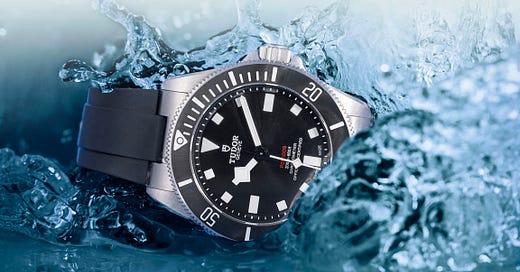By now the dust has started to settle from the launch of the new Tudor Pelagos 39mm, but good heavens if it didn’t make a splash (to make a feeble, dive-watch adjacent joke). The Pelagos 39 (a suitably laconic name for a technical dive watch) is, as the Brits like to say, just what it says on the tin: A 39mm Pelagos dive watch, with snowflake hands, ceramic bezel, and 200M water resistance. It’s only the third really new model in the Pelagos lineup since the first version launched in 2012 (depending on what you consider “new”).

Rolex is generally known to take a very incremental approach to updating its key models, although it sometimes does things that make me wonder if the board members of the Wilsdorf Foundation don’t enjoy a good troll as much as the next person. The GMT Master II with the crown on the left, which Rolex steadfastly refuses to call an LHD (Left Hand Drive) watch, despite the fact that fellow brand Tudor happily used the acronym when the Pelagos LHD came out, is a case in point. The refusal to use any such terminology reminds me a little of a family holiday dinner when everyone sits down and refuses to acknowledge by word or deed that one of the kids bears a startling resemblance to the mailman.
Because changes are made relatively seldom and are usually fairly minor, such changes are disproportionately noticed and commented on by watch enthusiasts. We’re a detail obsessed bunch at the best of times anyway, but Rolex’s approach to product development really highlights that characteristic (one typical, to be fair, of pretty much any enthusiast community).
Now, with the Pelagos (the name, by the way, is from the Greek, πελαγοσ – pelagos – or sea, from which we also get the word “pelagic”) the approach has been not so much incremental as virtually non-existent. This is not to say that there have not been updates and changes to the line since the 2012 launch – in 2015 the movement was updated from an ETA caliber to the MT5612; in 2016 the LHD came out and last year we got the FXD. I loved the FXD when it came out, and still do, but with its bidirectional bezel and fixed lugs (lest we forget, FXD means “fixed” in this case) it felt, like the LHD before it, like more of an interesting detour than a real evolution of the Pelagos line overall.
Which is, I think, part of the reason – a big part of the reason – that the Pelagos 39 hit as hard as it did. It feels like the first real update to the line since the first launch (and, arguably, the introduction of a non-ETA movement in 2015) and it is both firmly connected to the original, and a major departure. The original Pelagos is, it hardly needs to be said, about as pure a representation of an unadorned technical dive watch as you can, from anyone, for any money – over-spec’d at 500M, slightly oversized at 42mm, equipped with an elaborate self-resizing clasp and a helium release valve. The new Pelagos 39 dispenses with all these things in favor of a topside-friendly 39mm x 11.8mm case size and while it shares the titanium case of the original release, here it feels a bit more like a concession to all-day comfort than to the technical requirements of saturation diving (which is the environment that takes the best advantage of the features of the original).
Naturally there are some folks who see the 39mm as a step down technically, and if you really want to be absolute about it I suppose it is, but I think it makes more sense for most of us than the 42mm model – more wearable certainly, and considering that even if you do dive, you’re probably going nowhere near the 200M depth rating of the Pelagos 39 (the limit for recreational diving, per the good folks at PADI, is 40 meters) I think you probably gain a lot more than you lose in wearability with the reduced case size and the absence of the completely superfluous HRV. (I haven’t seen the watch in person but the sunray finish on the dial and bezel is, if not as resolutely unornamented as the matte dial and bezel on the original, apparently fairly unobtrusive, at least in low light).
One big question for me, however, does have to do with another kind of spec: METAS certification. Tudor rolled out its first METAS-certified watch in 2021 – the Black Bay Ceramic which, in some respects, bears more than a passing resemblance to the Pelagos 39, come to think of it. A METAS-certified Pelagos 39 would have been very much in keeping with the technical flavor of the Pelagos and it would have given the 39 a major point of differentiation and distinction from the 42 – I can’t help but think that if the 39 had been released with METAS certification, the 500M rating, self-adjusting clasp, and HRV of the 42mm model would hardly have been missed. (METAS certification, you’ll recall, includes both COSC certification and resistance to magnetic fields at least as strong as 15,000 gauss, as well as a battery of other tests). This is not to say, of course, that we won’t get a METAS-certified (albeit probably more expensive) Pelagos 39 in the future and if and when we do, it’ll be another step towards building in some new and impressive technical specs for what, up until now, was something of a one-model line.




